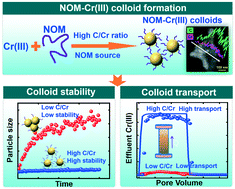Formation, aggregation, and transport of NOM–Cr(iii) colloids in aquatic environments†
Abstract
The complexation of natural organic matter (NOM) with chromium (Cr) represents an integral part of Cr cycling in nature. To date, most studies on the interaction of NOM with Cr(III) have focused heavily on the geochemistry of soluble NOM–Cr(III) complexes. However, there is a paucity of information regarding the colloidal chemistry of NOM–Cr(III) particles, which leaves a critical knowledge gap on the fate and colloid-mediated transport of Cr(III) particles. Herein, we explored the formation of NOM–Cr(III) colloids across a wide range of aquatic conditions and quantified their microscopic structures as well as subsequent aggregation and transport behaviors using an array of complementary techniques. Batch results show that the formation and stability of NOM–Cr(III) colloids depend on the C/Cr ratio and NOM source. The concentration and stability of NOM–Cr(III) colloids increase with increasing molar C/Cr ratio. Suwannee river humic acid (SRHA)–Cr(III) colloids are much more stable than Aldrich humic acid (AHA)–Cr(III) colloids, likely due to lower cation bridging and stronger repulsive hydration interactions. Characterization of colloids demonstrates that Cr(III) has six neighboring oxygen atoms in an octahedral geometry and that NOM is relatively enriched on the colloid surface which enhanced the particle stability through electrostatic and steric interactions. Examination of particle stability in natural waters indicates that NOM–Cr(III) colloids can be stable in river waters and groundwaters with low electrolyte concentrations. Results from column studies further confirm that the stable NOM–Cr(III) colloids can be transported readily during advective transport in the porous media. Collectively, these findings provide new mechanistic insights on the formation and stability of NOM–Cr(III) colloids, which are essential for evaluating the long-term fate of Cr and optimizing Cr remediation technology in organic-rich environmental settings.

- This article is part of the themed collection: Environmental fate of nanomaterials


 Please wait while we load your content...
Please wait while we load your content...